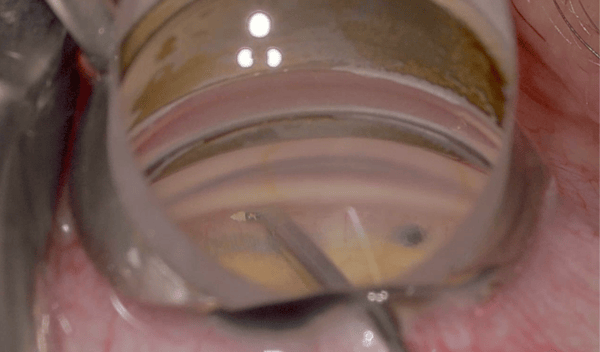Procedures to alleviate eye pressure associated with blinding diseases such as glaucoma date back over a century. Although glaucoma, a condition that damages the eye’s optic nerve, allows for a number of treatment options prior to surgery, including drops and lasers, research has shown traditional surgical techniques could result in higher risks of vision complications, longer recovery times, and higher associated costs. Identifying this disconnect, Malik Y. Kahook, MD, professor of ophthalmology and the Slater Family Endowed Chair in Ophthalmology at the University of Colorado School of Medicine, sought out a more accessible and practical solution to propel glaucoma treatment into the 21st century.
“Most surgical approaches are effective but also carry a significant amount of risk for complications. I saw an unmet need to provide a cost-effective method, allowing for accessibility across the world, to decrease eye pressure by removing the trabecular meshwork, which is the diseased tissue that blocks fluid outflow, from the eye,” Kahook says. “This resulted in the invention of the Kahook Dual Blade.”
Kahook started inventing the Kahook Dual Blade (KDB) a decade ago on the CU Anschutz Medical Campus, bringing the novel device to market in 2015 in partnership with New World Medical. The KDB offers surgeons and patients a cost-effective, single-use tool to allow for regular excisional goniotomy, opening up clogged drainage pathways in the eye without expensive capital equipment. The KDB’s breakthrough ramp and dual blades allows surgeons to lift and stretch the trabecular meshwork while making parallel incisions to cleanly remove the diseased tissue and minimize residual leaflets left behind.
Reaching surgeons and patients across the globe
While the intricate design of the blade was transformative for the advancement and safety of minimally invasive glaucoma surgery (MIGS), Kahook’s mission was to increase access and quality of glaucoma treatment options across the globe.
Sharing the same passion, his partnership with New World Medical helped to ensure the device landed in the hands of those who needed it most.
“When the KDB came on the market, it provided an efficient, accessible way for surgeons to perform excisional goniotomy, not only in developed countries, but also in developing countries,” he says. “I always look for people to team up with that are like-minded and come in talking about societal impact rather than the financial side of things. With this partnership, we talked about the humanitarian impact. We agreed that any collaboration would require the device to be accessible for underdeveloped or low- and middle-income countries.”
With more than 3 million people in the U.S. and 60 million globally affected by glaucoma, the KDB has become one of the world’s most commonly used tools to treat mild to severe cases of glaucoma in a minimally invasive approach. Reducing complications and recovery time, the tool can also be used in conjunction with cataract surgery.
The Ophthalmologist Magazine noted in its 2015 Innovation Awards that the KDB has increased patient safety and access in underserved areas while lowering costs.
The next generation
Since its public release in 2015, surgeons who have become adept at using the dual blade at the Sue Anschutz-Rodgers Eye Center and beyond have offered feedback to further Kahook’s mission for eye health equity.
Integrating this updated research and feedback, Kahook and New World Medical engineers designed a new version of the blade, the KDB Glide, which launched last year to enhance the comfort, ease of use, and universality of the tool. With narrowed sides and a micro-engineered footplate, the upgrades accommodate an expansive range of eye shapes, sizes, and contours around the world.
 Intraoperative image of the KDB Glide approaching the targeted trabecular meshwork for excisional goniotomy.
Intraoperative image of the KDB Glide approaching the targeted trabecular meshwork for excisional goniotomy.
“The original KDB was really good for the majority of patients, but there were outliers in the tails of the bell curve where the procedure itself could have been made smoother,” Kahook says. “By refining the dimensions of KDB, the device can better reach the tail ends of the bell curve. Since then, overwhelmingly surgeons who were adept at using the original KDB and are now using the KDB Glide think it's a great improvement because it glides smoother in the canal.”
He says some of the most notable improvements have been seen in populations or patients that may have smaller or irregular anatomies. The early success of the new model, and eagerness of his colleagues at home and worldwide to support the MIGS advancement, inspires Kahook to continue gliding in the right direction through the next decade.
“The dream of any inventor in the medical field is to change the lives of patients and provide the best possible methods for restoring health,” Kahook says. “I feel lucky to partner with a mission-driven organization and to be part of this supportive environment and innovative culture within the Department of Ophthalmology.”
.png)

.png)

.png)